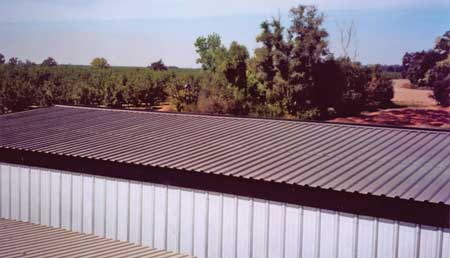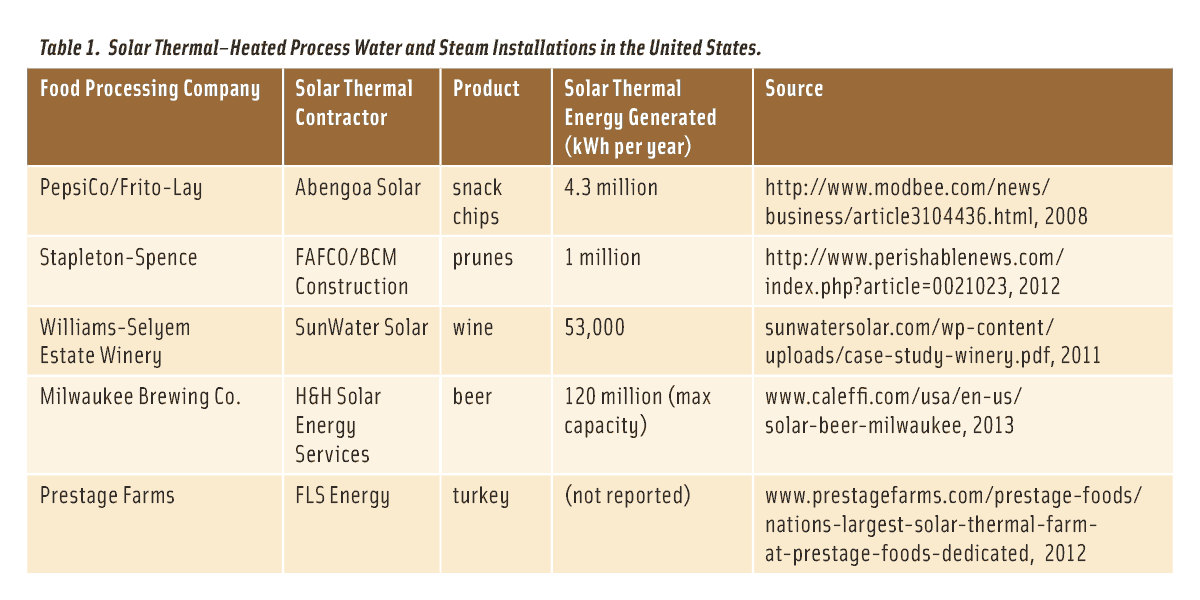Solar Thermal Processing of Foods for Small Operations
PROCESSING
“We are like tenant farmers chopping down the fence around our house for fuel when we should be using Nature’s inexhaustible sources of energy—sun, wind and tide. ... I’d put my money on the sun and solar energy. What a source of power! I hope we don’t have to wait until oil and coal run out before we tackle that.”
—Thomas Edison
Sunlight has by far the highest theoretical potential of the earth’s renewable energy sources. It is my privilege to co-author this month’s column with Rebecca Milczarek, a leader in the development and application of solar thermal processing for foods.
For businesses and households, “going solar” most often means using sunlight to provide electricity via the technology of photovoltaics. According to the Solar Energy Industries Assoc., the United States now has 20 gigawatts of installed solar electric power capacity. The food industry can benefit from a different use of solar energy: generation of process heat from sunlight. This approach is known as solar thermal processing.
Solar thermal processing is not new to the food industry. Direct sun drying of plant and animal food materials was one of the first food processing techniques employed by humans. Middle Eastern and East Asian cultures were sun-drying foods as early as 12,000 B.C.E. Early Bronze Age (3,300 B.C.E. to 2,100 B.C.E.) raisins and dried figs were recently identified in an archaeobotany study of a site in modern-day Pakistan. Today solar thermal food processing technologies encompass much more than simple sun drying, and they can be divided into three application areas: drying, cooking/baking, and other heat-driven processes.
 Applications of Solar Thermal Processing
Applications of Solar Thermal Processing
• Solar Thermal Drying. Solar thermal drying systems are categorized by the mode of solar energy transfer: direct, indirect, or mixed method. Direct solar drying involves the placement of the product on horizontal beds exposed to sunlight, although a glass or plastic covering may be used to prevent contamination and consumption by animals. In an indirect system, sunlight is incident on a solar collector (usually a metal box with a dark cover); the heated air is drawn through the solar collector into a drying chamber, where the product is arranged in a single layer on perforated trays. Mixed method solar drying involves both the direct (incident solar radiation) and the indirect (solar-heated air circulation) drying modes. For any of the three modes, air flow may be caused by natural convection (“passive”) or forced convection from a fan (“active”).
There have been many studies on small-scale dryers, especially in the field of design for rural areas of developing countries. In these areas, the lack of reliable power sources for active solar drying makes the passive design approach more appealing. Recent designs for passive small-scale solar dryers have been published for the drying of myriad fruits and vegetables (Hussain et al. 2008). For small farms and cottage food processing businesses, numerous small-scale dryer designs are available online, and dryer construction kits are available from companies such as SunWorks Technologies LLC (solarfooddryer.com).
Active solar dryers have the added advantage of forced convection and are thus superior to passive solar dryers when the electrical power infrastructure is sufficient, as would be the case in the developed world. Small-scale active solar dryers have been designed for mint leaves (Dalgıç et al. 2012), mulberry (Akbulut and Durmus 2009), Mexican tea (Kane et al. 2008), olive leaves (Nourhène et al. 2008), bitter gourd (Sreekumar et al. 2008), grapes, green beans, sweet peppers, and chili peppers (Tiris et al. 1995).
Medium- and large-scale industrial applications of solar thermal drying are covered sparsely in the scientific literature but have been implemented in a handful of installations in the United States. Many commercial systems available at this time are of the SolarWall brand, designed by Conserval Engineering (solarwall.com). SolarWall technology modifies the wall of an existing or new building to become a transpired solar collector. Solar-heated air is directed to a fluidized bed or tray dryer inside the building. In the United States, processors have used SolarWall systems for drying herbs, plums, and walnuts; abroad, the dryers are used for tea and coffee. A feasibility study conducted for the Spices Board of India found that a sesame seed–drying system based on SolarWall technology would have a payback period of just over two years (Hollick 1999). Other commercially available solar thermal air heating systems that have reported industrial food drying applications include MatrixAir (matrixenergy.ca), Lubi/Unitair/Luba GL (enerconcept.com), InSpire (atas.com), Northern Comfort (sunsiaray.com), and others.
• Solar Thermal Cooking and Baking. Solar cooking, once only the realm of campers and natural disaster survivors, is making its way into mainstream food processing. Championed by several groups, including the International Solar Energy Society, solar cooking generally involves concentrating solar energy via concave mirrors. India, in particular, has been the site of several innovative solar cooking and baking installations, with reported applications for bread baking, milk pasteurization, herbal syrup preparation, and institutional cooking (Eswara and Ramakrishnarao 2013).
As with solar dehydrators, there are many free designs and kits for purchase online for small batch (1–10 lb) cooking. For larger quantities, fewer options are available. Sun Ovens International (sunoven.com), for example, sells a trailer-mounted oven. Several larger solar thermal cooking installations that use parabolic dish reflectors have been operating in India for about a decade (Eswara and Ramakrishnarao 2013). These installations are primarily used by community groups and institutions for daytime food preparation. Hybrid systems that can utilize both sunlight and a backup source of energy are helpful for food processors who desire continuous operation. The Sun Ovens International Villager Sun Oven is an example; it has a propane secondary heating system.
--- PAGE BREAK ---
• Other Solar Thermal Heat-Driven Processes. Solar thermal systems can heat process water or create steam, both of which are used extensively in the food processing industry. Table 1 summarizes some publicly announced solar thermal–heated process water and steam installations in the United States. In addition, boutique products such as solar-roasted coffee (Solar Roast Coffee LLC, solarroast.com) and peanuts (Tinytech Plants, tinytechindia.com) highlight other innovative uses of solar thermal energy in food processing.
 Opportunities for the Future
Opportunities for the Future
The search for new applications of solar thermal process heating in the food industry continues. Currently more than 34 countries have active research programs in solar thermal food processing. Researchers from the U.S. Dept. of Agriculture’s Agricultural Research Service and the University of California Advanced Solar Technologies Institute were recently awarded a California Dept. of Agriculture Specialty Crop Block Grant Program grant to develop a solar thermal drum dryer for specialty crop purees and pomaces.
This short column focused on solar thermal collection systems and applications for foods. Additional research is currently being performed to develop new systems to efficiently concentrate and store solar energy for use during periods when sunlight is not available.
 Tara McHugh, PhD, Contributing Editor
Tara McHugh, PhD, Contributing Editor
Research Leader, USDA
Agricultural Research Service, Albany, Calif.
[email protected]
Rebecca Milczarek, PhD, is Research Agricultural Engineer at the U.S. Dept. of Agriculture, Agricultural Research Service, Healthy Processed Foods Research Unit, Albany, Calif. ([email protected]).
References
Akbulut, A., and A. Durmus. 2009. Int. J. Energy Res. 33: 687-695.
Dalgıç, A. C., H. Pekmez, and K. B. Belibağlı. 2012. J. Food Sci. Technol. 49(4): 439–449.
Eswara, A. R. and M. Ramakrishnarao. 2013. J. Food Sci. Technol. 50(2): 209–227.
Hollick, J. C. 1999. Renew. Energ. 16: 714–719.
Hussain, M. Y., Islam-ud-Din, and M. Anwar 2008. Int. J. Agri. Biol. 10: 333–336.
Kane, C., S. Ethmane, A. Jamali, M. Kouhila, A. Mimet, and M. Ahachad. 2008. Chemical Eng. Communications. 195(7): 787–802.
Nourhène, B., K. Mohammed, and K. Nabil. 2008. Food Bioprod. Process. 86: 176–184.
Sreekumar, A., P. E. Manikantan, and K. P. Vijayakumar. 2008. Energ. Convers. Manage. 49: 1388–1395.
Tiris, C., N. Ozbalta, M. Tiris, and I. Dincer. 1995. Int. Comm. Heat Mass Transfer. 22(3): 411-423.


